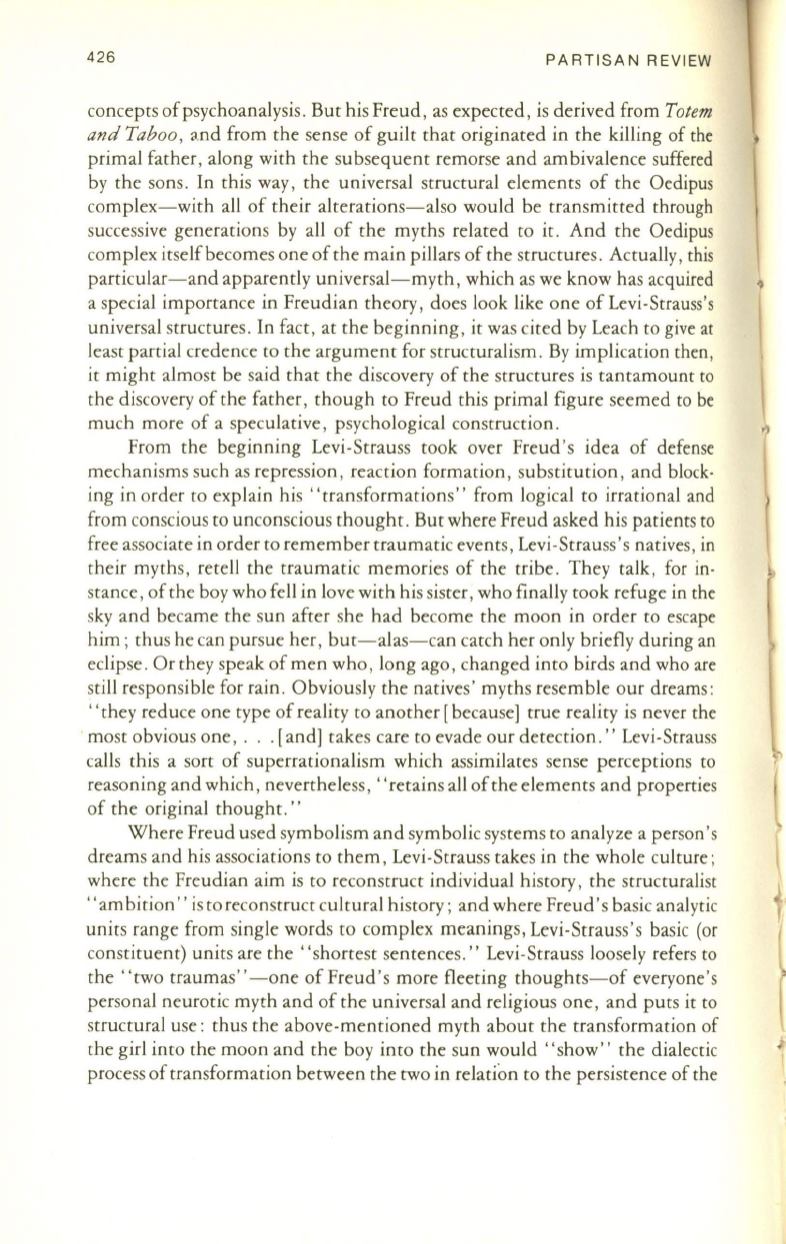
426
PARTISAN REVIEW
concepts of psychoanalysis . But his Freud, as expected, is derived from
Totem
and Taboo ,
<1.nd from the sense of guilt that originated in the killing of the
primal father, along with the subsequent remorse and ambivalence suffered
by the sons . In this way, the universal structural elements of the Oedipus
complex-with all of their alterations-also would be transmitted through
successive generations by all of the myths related to it. And the Oedipus
complex itself becomes one of the main pillars of the structures . Actually, this
particular-and apparently universal-myth, which as we know has acquired
'I
a special importance in Freudian theory, does look like one of Levi-Strauss's
universal structures . In fact, at the beginning, it was cited by Leach to give at
least partial credence
to
the argument for structuralism. By implication then,
it might almost be said that the discovery of the structures is tantamount
to
the discovery of the father , though to Freud this primal figure seemed to be
much more of a speculative, psychological construction.
.,
From the beginning Levi-Strauss took over Freud's idea of defense
mechanisms such as repression, reaction formation, substitution, and block-
ing in order
to
explain his' 'transformations" from logical to irrational and
\
from conscious to unconscious thought. But where Freud asked his patients to
free associate in order to remember traumatic events, Levi-Strauss' s natives , in
their myths, retell the traumatic memories of the tribe. They talk, for in–
stance , of the boy who fell in love with his sister, who finally took refuge in the
sky and became the sun after she had become the moon in order to escape
him; thus he can pursue her, but-alas-can catch her only briefly during an
eclipse. Or they speak of men who, long ago, changed into birds and who are
still responsible for rain. Obviously the natives' myths resemble our dreams:
"they reduce one type of reality to another [because) true reality is never the
most obvious one, ... [and) takes care to evade our detection." Levi-Strauss
calls this a sort of superrationalism which assimilates sense perceptions to
reasoning and which, nevertheless , "retains all of the elements and properties
of the original thought ."
Where Freud used symbolism and symbolic systems to analyze a person's
dreams and his associations to them, Levi-Strauss takes in the whole culture ;
where the Freudian aim is to reconstruct individual history, the structuralist
" ambition" is
to
reconstruct cultural history; and where Freud's basic analytic
units range from single words to complex meanings, Levi-Strauss's basic (or
constituent) units are the' 'shortest sentences." Levi-Strauss loosely refers
to
the "two traumas"-one of Freud's more fleeting thoughts-of everyone's
personal neurotic myth and of the universal and religious one, and puts it
to
structural use: thus the above-mentioned myth about the transformation of
the girl into the moon and the boy into the sun would' 'show" the dialectic
process of transformation between the two in relation
to
the persistence of the


